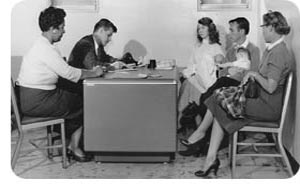The groundswell of support for reform continued to grow. In 1950, Geri Joseph published a follow-up series, noting improvements in the state institution system.
Among the improvements: A shared diet for both employees and residents, the nation's first "Patient Bill of Rights," and establishment of the nation's first volunteer services office.

By the 1950s, some improvements were seen.

Infants with developmental disabilities were removed from their families shortly after birth and placed in institutions.
Despite these advances, the "medical model" for treatment continued to prevail. Infants with developmental disabilities were removed from their families shortly after birth and placed in institutions. Some parents even turned their babies over in their strollers to prevent anyone from seeing their children's disabilities.
Unfortunately, the medical model continued to be the standard for decades.
In 1951, Governor Youngdahl left office and the campaign for improved treatment of people with development disabilities lost one of its greatest champions. Fortunately, his successor, Governor C. Elmer Andersen, shared Youngdahl's passion for improving conditions at state-run hospitals.
In 1954, several years into his four-year term, Governor Andersen requested a report detailing the current condition of state hospitals. Unfortunately, the report wasn't completed until 1956 and was delivered to Andersen's successor, Governor Orville Freeman.

Governor C. Elmer Anderson:
Sharing the Vision






